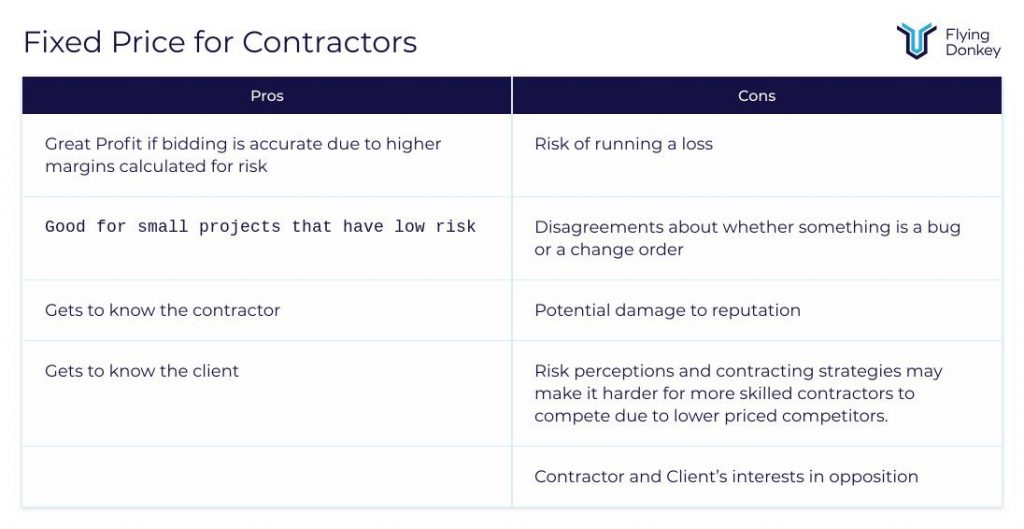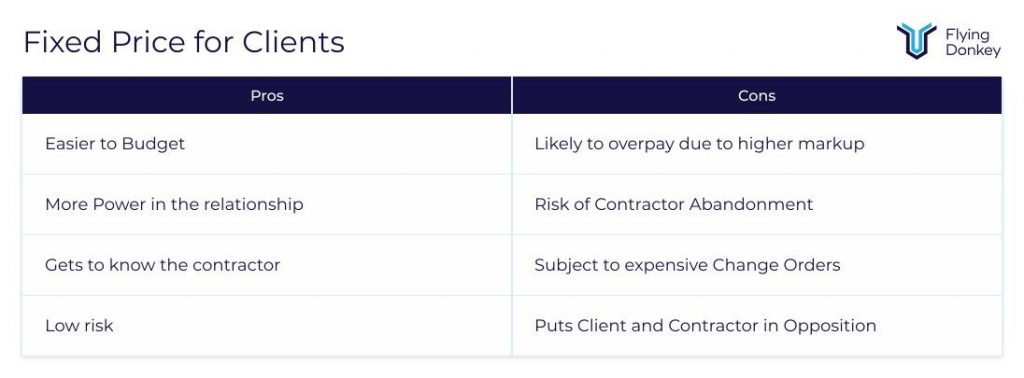Have you ever hired a contractor to perform a project and end up not getting what you were promised? It’s frustrating. It wastes your time, money, and slows down your business initiatives. Because we believe our success is driven by your success, we have taken a unique approach to contracts. We use aspects of both Fixed Price and Time and Material contracts to create a scenario where we reduce risks for client projects. We’ll look at:
- Pros and Cons of Fixed Price Contracts
- Pros and Cons of Time and Materials Contracts
- Use of Credits
- Benefits of Becoming a Partner
For each section, we’ll also discuss how Flying Donkey has developed a strategy to limit the risks involved.
Fixed Price Contracts
A fixed price contract is an all-inclusive price that covers the cost of all labor, materials, and profit of an organisation. These contracts hold risks for both sides of the contract. The truth is a fixed price estimate is IMPOSSIBLE to estimate effectively during software development because the service provider is guesstimating what they will need based on the information and experience they have. We’ll look at how fixed price contracts work for clients followed by how they work for contractors.
Clients
The client tends to have the better end of fixed price contracts assuming they are delivered. A fixed price contract allows the client to budget exactly what they need to the project. It gives them power to require work completed before the contract is complete, but also runs the risk of a contractor abandoning the project. The client is likely to overpay if a project goes smoothly because the contractor bids in a way to protect from the risk that the project becomes more cumbersome than originally expected.
Contractors
From a contractors standpoint, fixed price contracts are full of risks. The biggest risk is they underestimate and end up taking a huge loss. Enough losses and the contractor goes out of business, but most contractors will protect against this in a variety of ways including very stringent contracts with lots of change requests (demanding more money). This builds a bad relationship where the client and the contractor’s interests aren’t truly aligned. In addition, contractors will abandon projects when they know they cannot satisfy the contract which will lead to the project running over budget due to the costs of hiring another company to complete it. Contractors that abandon a project or look for ways to increase the price will eventually harm their reputation and fail to get more business.

Due to the risks involved, Flying Donkey only uses fixed price contracts on small projects. They are typically the first design projects with a new client. We create a semi-functional prototype to give the client an idea of the look and flow of the design. Once the design is agreed upon, then we provide a time and materials bid for the actual development.
Time and Materials Contracts
Time and Materials Contracts are similar to Fixed price contracts but allow more flexibility. A fixed price contract passes material costs on to the client and charges them an hourly rate for the labor. These contracts offer a different set of benefits and risks than fixed price contracts for both the client and the contractor. We’ll look at each.
Clients
From a client’s perspective, there are pros and cons, but they tend to balance out. While it is harder to budget and could end up more expensive than a fixed price contract, the ability to save money when things go smoothly and the ease of adjusting project goals make it where the tradeoff is equitable. These contracts also put the client and contractor goals in alignment as long as you have a trustworthy contractor. If you don’t have a trustworthy contractor, you run the risk of them intentionally driving costs up to make more money. The risks are why most clients would prefer a fixed cost project, but it is not always the best option.

Contractors
From a contractor perspective, this type of project is preferable. The financial risk is lower should unexpected issues occur, changes to project are easier to make, and it aligns the contractor and client goals of achieving the best software. The only real risk from a contractor spot is the smoothest projects might be less profitable.

We obviously prefer the time and materials projects because it allows us to focus on quality over budgetary constraints, but any new client will start with a smaller fixed price contract to develop a comfort working with each other. Because we know that fiscal planning is crucial to corporate success, we also allow client’s to put monthly limits on hours so they can accurately plan their budgets. In the next section, I’ll discuss the use of credits which we use when needed to reduce costs due to certain challenges.
Use of Credits
Credit Hours may occur once a task, milestone, or issue is completed. Common reasons for credit hours may be learning a new programming language, research that benefits both the client and Flying Donkey, or when we make a mistake that add unnecessary hours. Any time a company is working with new software, it takes time to analyse how it functions. Time taken getting familiar with the way your software is currently set up typically gets a 30% credit during the first project or month (whichever is shorter) to reduce the cost of the learning curve. This is used as a form of checks and balances.
Benefits of becoming a Partner
At Flying Donkey, we prefer to partner with organisations that believe in focusing on continuous improvement through software innovation. Our approach is based on providing custom software that helps your employees and customers save time. We believe that this helps improve your bottom line. This belief is the driving force behind our contract philosophy that progresses through the following path:
- Project Scope: Define the scope of a project.
- Small Fixed Price Contract to give idea of concept of design and concept of how the software will work.
- Larger Time and Materials Contract using agile project management to create fast meaningful changes to software.
- Manual Software Testing by one of our QA experts to make sure the software operates properly.
- Deployment- Release new development to customer.
- Credit Hours if necessary.
- Support of existing software and continued development of new features.
We have found this methodology creates superior relationships and results for our clients. If you have any questions, please reach out. I’m always happy to help.





